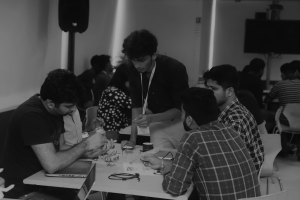It is time to bring radical changes in the education system.
There are approximately more than 38 million students in India who pursue higher education, the ones on whom the nation depends on its transformation. There are numerous Small Medium Enterprises (SME’s), who employ semi-skilled individuals (in terms of technology), looking to enhance their business. SME’s are a strong pillar of the nation’s economy as they employ a large segment of the nation’s workforce. However, the intervention tools and business transformation infrastructure that we are educated with, within higher educational institutions, are barely put to work in these SME’s. Further the communities of handicraftsmen — potters, weavers, carpenters, painters — whose income relies on their artistic skills — have not yet harnessed the potential of the Internet economy. One of the largest sectors in the Indian economy, the agricultural industry, is yet to find solutions for various issues such as warehouse management, prediction of weather/soil for best yield, credit facilities for farmers, etc. Likewise, there are challenges that one can find in every sector and it will continue to be so. With the advent of new fields there will be newer opportunities and with it — CHALLENGES.
While education today equips learners with the knowledge of emerging technologies to become part of the opportunity, the bigger question of “WHY” is still in the dark. Why should we learn or acquire skills in the latest technologies? Is it just to earn higher packages or is there more to it? Without a clear direction from Higher Educational Institutes (HEI’s), the purpose of students has been fixed to short-term outcomes such as higher packages, jobs in foreign countries, and so on. The knowledge acquired by students is certainly used to build wealth for the nation by providing services to western or middle eastern countries, but a certain percentage, <5% of students who have leadership qualities should focus on developing communities within the nation. These could be by policy interventions or schemes that are SME friendly, that could be announced from the top (Government) to the bottom (SME’s). This also has to be initiated at the ground level by working with the communities. Such interventions are only possible when HEI’s make communities their focus.
“Because of the flexibility that community colleges afford, many students do not have to choose between an education and fulfilling other responsibilities- they can do both” — Jill Biden
Bringing communities within the Institution curriculum framework has its advantages. The Industries and local communities, apart from sharing their needs, also become a part of the education process. They share their resources and knowledge base with the students with the hope that some transformation will be seen. This kind of collaboration expands the horizon of knowledge in students as the knowledge flows from multiple sources. The Institutions will no longer be constrained with resources and would get access to community resources. Institution brand value shall thus increase, attracting more students with a similar mindset, but most importantly the students will be learning with a purpose. The urge to empower their communities, where they were sent from, makes education a responsibility rather than just a phase of life.
In today’s scenario, where students enroll into HEI’s without a purpose, a community-centric education will aim to bring the purpose back in education.
We would nurture compassionate and competent engineers rather than merely skilled engineers who do not know which way to head!

